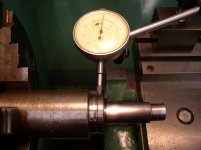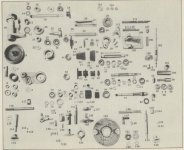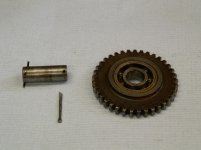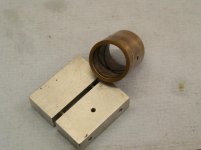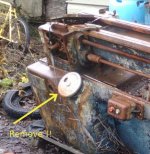CarbideTip
Aluminum
- Joined
- Sep 21, 2016
- Location
- Woking, Surrey, UK.
Hi all,
In late 2016 I acquired a CVA toolroom lathe and as my existing rotary converter wasn't up to powering the 4HP motor I decided to rewire it completely with a new motor and VFD. That was finished a while back and I've used the lathe a bit since to get an idea of what else needs doing. It was made in 1961 so I wasn't too surprised that it wasn't oil tight in some places.
One of those places was the power feed shaft exit from the feed gearbox. I'm now in the process of fixing this.
For starters I read one of the posts here on removing the feed gearbox from a round-dial 10EE. That was most helpful, as the process is almost identical.
Added 2022: I forgot to mention that on CVA's the main gearbox speed selector wheel needs to be removed first. You cannot get the gearbox out with it in place.



The end cover was then easy to remove.

At this point I was dismayed to see the mess.
It looks to me like the box has suffered from ingress of coolant, possibly running along the leadscrew and in via the broken seal.
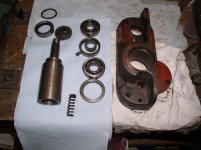
The seals all seem to have been leather with a gaiter spring. Were 10EE's fitted with leather seals too?
I have ordered new bearings for the feed shaft and nitrile seals to replace the originals, but the worst part is that the bearings in the main gearbox.

The two bearings indicated are so bad that you can lift the shaft by about 1/16". If you lift the lower one it pushes the upper one up too!
I've now taken the front cover off too.
There was about 1/2" of brown sludge in the bottom of the gearbox, but as far as I can see there are no broken or missing teeth.
The uppermost bearings on the lead-screw shaft (which I've read are difficult to get A/C's in 10EE's) seem to be OK.
Incidentally, all the feeds were working prior to dismantling.
I've read (&re-read) dgfoster's account of replacing one of the gears on the cone shaft in a round dial 10EE, but I don't see how the shafts come out.
Help!
Martin.
In late 2016 I acquired a CVA toolroom lathe and as my existing rotary converter wasn't up to powering the 4HP motor I decided to rewire it completely with a new motor and VFD. That was finished a while back and I've used the lathe a bit since to get an idea of what else needs doing. It was made in 1961 so I wasn't too surprised that it wasn't oil tight in some places.
One of those places was the power feed shaft exit from the feed gearbox. I'm now in the process of fixing this.
For starters I read one of the posts here on removing the feed gearbox from a round-dial 10EE. That was most helpful, as the process is almost identical.
Added 2022: I forgot to mention that on CVA's the main gearbox speed selector wheel needs to be removed first. You cannot get the gearbox out with it in place.



The end cover was then easy to remove.

At this point I was dismayed to see the mess.
It looks to me like the box has suffered from ingress of coolant, possibly running along the leadscrew and in via the broken seal.

The seals all seem to have been leather with a gaiter spring. Were 10EE's fitted with leather seals too?
I have ordered new bearings for the feed shaft and nitrile seals to replace the originals, but the worst part is that the bearings in the main gearbox.

The two bearings indicated are so bad that you can lift the shaft by about 1/16". If you lift the lower one it pushes the upper one up too!
I've now taken the front cover off too.
There was about 1/2" of brown sludge in the bottom of the gearbox, but as far as I can see there are no broken or missing teeth.
The uppermost bearings on the lead-screw shaft (which I've read are difficult to get A/C's in 10EE's) seem to be OK.
Incidentally, all the feeds were working prior to dismantling.
I've read (&re-read) dgfoster's account of replacing one of the gears on the cone shaft in a round dial 10EE, but I don't see how the shafts come out.
Help!
Martin.
Last edited:


